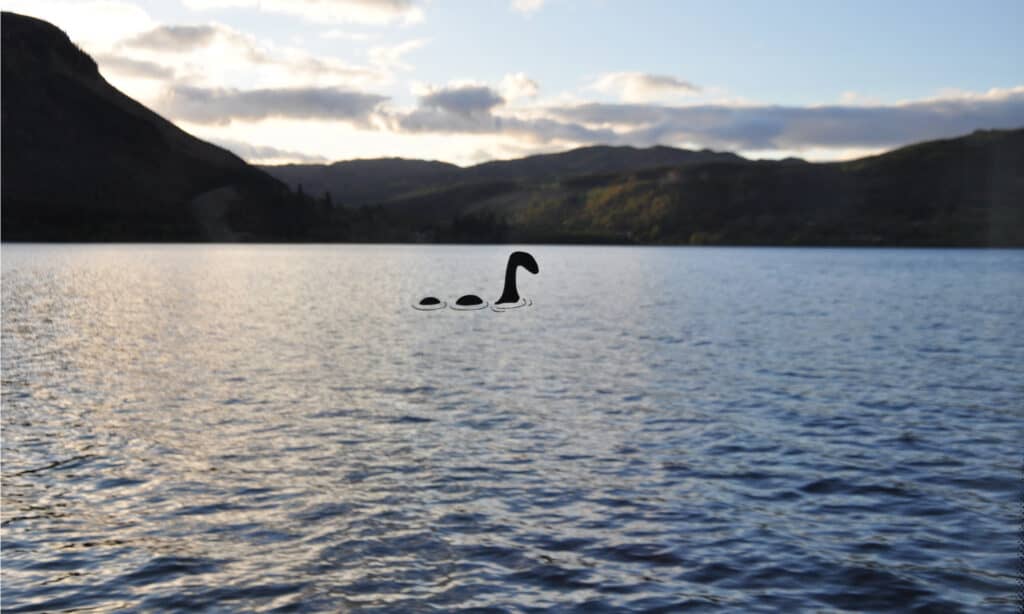Loch Ness, which is a lake located in Scotland, is a site of mythology, story-telling, and fascinating history. Many people associate the body of freshwater with the notorious Loch Ness monster, also known as “Nessie.” While people are still unsure whether the Loch Ness monster exists, keeping the story alive through centuries has sparked imagination, experiments, and excitement across the globe. The alluring Loch Ness monster coupled with the lake’s beauty and size makes it one of a kind. Discover how deep Loch Ness is and what lurks in the depths of its waters.
Background on Loch Ness

Many believe the prehistoric monster lives in Loch Ness.
©Yulia_Bogomolova/Shutterstock.com
Loch Ness is the name of a lake in Scotland located in the Highland council area. The Highland forms the uppermost portion of the United Kingdom. Much of the Highland is comprised of valleys and lakes within a great plateau. Loch Ness stretches 23 miles long and has the greatest volume of freshwater in the United Kingdom. Glen Mor, meaning “Great Valley”, is a geographical feature in the Highland in which Loch Ness resides.
The drainage basin of Loch Ness measures more than 700 square miles. Rivers within the Loch Ness watershed include the Oich and the Enrick. Loch Ness’s outlet is River Ness, whose current flows into Moray Firth. Moray Firth is an inlet of the North Sea located in northeastern Scotland. Something that makes Loch Ness unique compared to other bodies of water in Scotland is the folklore that surrounds it. Many believe that a prehistoric monster haunts the depths of Loch Ness.
How Deep is Loch Ness?
If you wonder how deep is Loch Ness, records indicate a depth of 788 feet. Its depth makes it the second-deepest lake in Scotland behind Loch Morar, which measures 1,017 feet deep. Although Loch Ness is not the deepest lake in the region, it does have the greatest volume of freshwater. Freshwater volume in Loch Ness amounts to approximately 1.95 trillion gallons or 1.775 cubic miles. Other large lochs–meaning lakes–in Scotland include Loch Awe, Loch Lomond, and Loch Shiel.
The Legend of Loch Ness
The myth of the Loch Ness monster dates back to the 7th century when Saint Columbia first recorded sighting the beast. St. Columbia was an Irish missionary best known for bringing Christianity to the country of Scotland. According to St. Columbia’s biography, the missionary had stopped at Loch Ness on a journey because he had heard of a great beast killing people around the loch. When St. Columbia arrived at the lake, he saw the monster attacking someone. St. Columbia, supposedly with the power of God, commanded to beast to leave. Following this encounter, reports of Loch Ness monster violence were never heard of again.
While the Loch Ness monster did not attack anyone after meeting St. Columbia, some people claimed to have seen the creature from afar. After a road was built along Loch Ness in 1933, a couple traveling on the road believed they had seen the Loch Ness monster in the lake. The story was published in the media, and the Loch Ness monster hysteria in the United Kingdom began. Media outlets in London wanted a piece of the action, and a circus offered a large sum to anyone that could bring them the Loch Ness monster.
Another couple claimed to see the Loch Ness monster on land during the same year, so the craze over the Loch Ness monster only grew. Marmaduke Wetherell, who was a big-game hunter during the time, was hired to search for and to capture the Loch Ness monster. Wetherell traveled to Loch Ness and discovered footprints belonging to a large animal.
However, it turned out that the footprints discovered by Wetherell belonged to a stuffed hippopotamus foot, according to the British Natural History Museum, which tested the prints. Following this discovery, people began to doubt the Loch Ness monster’s existence.
The Legend of the Loch Ness Monster Continues
In 1934, the infamous picture of “Nessie” was taken. The picture showed a creature poking its head out of the rippling water. The beast looked similar to a sauropod, which is a long-necked dinosaur.
The image caused many to believe that Nessie was an aquatic plesiosaur, a species that was assumed to have gone extinct around 65 million years ago. Others speculated that Nessie was an archeocyte. The term “archeocyte” describes an ancient whale with a long neck that was believed to have gone extinct 18 million years ago. However, some thought that Nessie was no more than a series of seiches, which are oscillations on the water’s surface that occur when cold river water meets the warmer water of Loch Ness.
In the last few decades, people have amped up their search for the Loch Ness monster. In fact, some universities in Britain used sonar technology to scan the depths of Loch Ness in the 1960s. The sonar equipment showed movements of large objects under the surface of Loch Ness, but no one could pinpoint what these objects were. Following this event, other institutions used sonar to try and detect what might lurk in Loch Ness waters. Boston’s Academy of Applied Science reported having discovered a giant beast in the depths that appeared like a plesiosaur.
Where is Loch Ness Located on a Map?
Located in the Scottish Highlands, Loch Ness is a substantial freshwater lake that stretches for about 37 kilometers in a southwestern direction from Inverness. Its name is derived from the River Ness, which originates at the northern tip of the lake.
Here is Loch Ness on a map:
The photo featured at the top of this post is © iStock.com/CloudVisual
Thank you for reading! Have some feedback for us? Contact the AZ Animals editorial team.







